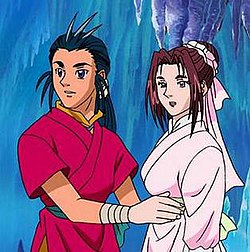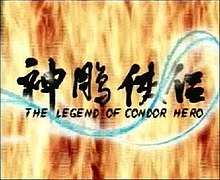This article needs additional citations for verification. (July 2007) |
The Legend of Condor Hero (神鵰俠侶 コンドルヒーロー, Shin Chō Kyō Ryō: Kondoru Hīro) is a Japanese/Hong Kongese anime adaptation of The Return of the Condor Heroes, a wuxia novel by Louis Cha.
| The Legend of Condor Hero | |
 Screenshot | |
| 神鵰侠侶 コンドルヒーロー (Shin Chō Kyō Ryō: Kondoru Hīro) | |
|---|---|
| Genre | Martial arts, Romance |
| Anime television series | |
| Studio | Nippon Animation Jade Animation |
| Original network | BS Fuji |
| Original run | October 11, 2001 – May 3, 2008 |
| Episodes | 78 |
| The Legend of Condor Hero | |||||||||||
|---|---|---|---|---|---|---|---|---|---|---|---|
 Title screen | |||||||||||
| Traditional Chinese | 神鵰俠侶 | ||||||||||
| Simplified Chinese | 神雕侠侣 | ||||||||||
| |||||||||||
Plot edit
The Legend of Condor Hero is set in the 13th century at the time of the Mongol invasion of China. Nearly a decade after the end of The Legend of the Condor Heroes, the Mongols have now conquered the Jin Dynasty and are now setting their sights towards the Southern Song Dynasty. The citizens of Southern Song, many of them great martial artists of the Central Plains, band together to defend their country from the onset of the Mongol horde. The story culminates in the historic Battle of Xiangyang, which was a critical battle that led to the fall of China to the Mongols.
The story revolves around the young martial arts fighter Yang Guo (Youka), who falls in love with his martial arts master, Xiaolongnü (Shouryuujo), and the trials and tribulations he goes through while searching for his love in war-torn China.
List of episodes edit
There are 78 episodes released of The Legend of Condor Hero. Season I is composed of two parts—episodes 1–12 and episodes 13–26. Season II takes after the end of Season I, starting from episode 27 to 52. Season III broadcast began in Taiwan and Canada in 2008.
The Japanese version was only made for the first series.
In all three series, Taiseng released the respective DVDs months before respective television broadcasts.
|
|
| ||||||||||||||||||||||||||||||||||||||||||||||||||||||||||||||||||||||||||||||||||||||||||||||||||||||||||||||||||||||||||||||||||||||||||||||||||||||||||||||||||||||||
Theme songs edit
Production edit
After Nippon Animation had obtained the rights of the series, it produced the animation version with association with Jade Animation (TVB's animation studio), and decided to split the series into 3 parts.
Video releases edit
Taiseng Entertainment released the first season for English-speaking audiences. Since the show was much more popular in Chinese-speaking nations than in Japan, the second season was not produced in Japanese like the first season, but in Cantonese and Mandarin.
VCD video of the series was released by Warner Bros. in Hong Kong.
External links edit
- The Legend of Condor Hero (anime) at Anime News Network's encyclopedia
- The Legend of Condor Hero reviews on spcnet.tv
- (in Japanese) The Legend of Condor Hero page on Nippon Animation website
- (in Chinese) The Legend of Condor Hero page on TVB website